Table of contents
- Report: All About Gasoline Part 3 Gasoline: the pros and cons of E5 and E10
- Winter tips
- E10 compatibility
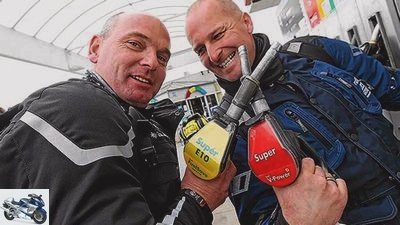
jkuenstle.de
counselor
workshop
Gasoline: the pros and cons of E5 and E10
Report: All About Gasoline Part 3
Gasoline: the pros and cons of E5 and E10
What can it be, E5 or E10, five or ten percent ethanol in gasoline, as much alcohol as in beer or light wine? Is the skepticism about E10 justified??
Thomas Schmieder
06/09/2011
The German people’s soul is cooking. E10, which with up to ten percent bio-ethanol contains twice as much alcohol as the previous Super E5, is not available to the beer drinkers. Car and motorcyclists hardly ever fill up with the supposed bio-petrol recommended by the federal government. And that although the E10 was initially five to eight cents cheaper than Super E5 or Super Plus. It was branded “Oko-Plorre” by the “Bild” newspaper.
In the USA E10 was introduced years ago, in Brazil the minimum ethanol content in gasoline is 22 percent, 25 percent alcohol is the rule. Around eleven million motorized two-wheelers drive it there. Nikolaus Otto was already running his engine with ethanol from potatoes in the 1860s. Shortly after 1900, gasoline was mixed with ethanol, the drinking alcohol, spirit. This is where the everyday name fuel, which is still used today, is derived. Ethanol can contribute to (domestic) agriculture. And thus on the one hand stretch fossil oil reserves, on the other hand make them less dependent on crude oil imports.
E5 has been standard for years, without any problems. Today, 6.25 percent of the energy content of fuels sold in Germany (petrol and diesel) must come from renewable raw materials. Pure ethanol has around two thirds of the energy content (calorific value) of conventional gasoline. However, the alcohol improves the filling, burns cleaner and knock-proof with a high octane number (108 RON).
Buy complete article
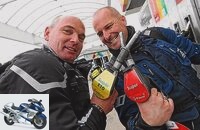
Report: All About Gasoline Part 3
Gasoline: the pros and cons of E5 and E10
3 pages) as PDF
€ 2.00
Buy now
Adding ten percent ethanol reduces the energy efficiency of the fuel. The power output can be a little lower, according to ADAC, consumption can increase by an average of 1.5 percent and a maximum of three percent. So far, E10 has only been sold as a 95-octane Euro super. Apparently the refineries have adjusted the fuel composition; otherwise the octane number would even have risen.
Ethanol needs almost three times as much energy to evaporate as hydrocarbons, hence the improved internal cooling. At extremely low outside temperatures, E10 could therefore cause starting problems that should disappear as the engine warms up. When it is hot, ethanol in the fuel increases the vapor pressure more than ten percent would suggest (anomaly). This is why the proportion of volatile hydrocarbons in E10 is usually reduced.
E10 even offers advantages for winter shutdown, see box below. The allegedly poorer shelf life of alcohol compared to fossil hydrocarbons is a fairy tale, the opposite is the case. The myth of shortened oil change intervals through “oil dilution” is also not true. The question of whether ethanol could further oxidize to aggressive acetic acid is controversial. This would cause micro-organisms in the tank (!), Says the company Wagner Lubricants, manufacturer of the petrol stabilizer “Bactofin”.

workshop
Report: All About Gasoline Part 2
Types of petrol, anti-knock properties and additives
read more
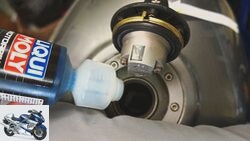
workshop
Guide to downtime and petrol
What should you watch out for with fuel??
read more

Jahn
The additional consumption from E10 to E5 is around 1.5 percent, depending on the engine and control technology. In a fleet test with eight BMW R 1200 GS, MOTORRAD determined around one percent more fuel consumption over a total of 15,000 km, around 0.06 liters / 100 km.
The oxygen introduced into the gasoline by the ethanol can lead to a lean mixture due to excess air during combustion in the engine, especially in carburettor engines, because in injection engines with a regulated catalytic converter, the need for combustion air is regulated via the lambda probe. After their first attempts with the E10, some motorcyclists report restless, “jerky” engine running.
In this country, filling stations must offer at least one E5 fuel for an unlimited period of time (grandfathering). In doing so, Germany goes beyond the EU requirements: Brussels only requires this until 2013.
It is estimated that around a million motorcycles in Germany cannot handle the E10, but the manufacturers issue a non-binding approval for the majority of the models. E10-compatible vehicles can tolerate mixtures with E5 in any ratio, each time they fill up. The quality-improving additive packages in branded fuels also swallow additional “alcohol” without a hangover. Accidentally spilled when refueling, E10 does no more damage to paintwork than E5. Regardless of the fuel: Splashes should be wiped off immediately with a soft cloth.
E10 can permanently and irreversibly damage machines that are not approved for this purpose with just one tank of fuel. What if you did not fill up the wrong way? Do not start the engine, drain the tank contents into a suitable container and, if possible, top up with Super Plus. In the case of metals, aluminum is considered to be endangered by ethanol, but only at high pressures and temperatures. And if it is “unpassivated”: When it comes into contact with the air, aluminum is covered with a very thin, but extremely stable and protective oxide layer.
Does E10 endanger fuel lines and seals? Only rubber hoses that do not meet the current DIN 73378 and 73379-1 standards. With older lines, in extreme cases, cracking and embrittlement could cause gasoline to get on hot parts of the motorcycle. For seals, E10 is no more critical than E5, says the Wagner company. On the contrary: “Gasoline-alcohol mixtures are less aggressive towards seals, the higher the proportion of alcohol in the mixture.”
And the environmental properties of E10? In relation to the proportion of ethanol, the federal government states a 35 percent reduction in the greenhouse gas CO2 compared to oil-based fuel, including the cultivation of oil plants. Exhaust gas measurements by the ADAC showed 0.9 percent fewer direct CO2 emissions despite the slight additional consumption.
Another positive aspect is that the carbon in bio-ethanol was not withdrawn from the atmosphere millions of years ago, but today. According to the Ministry of the Environment, 90 percent of the bio-ethanol used in Germany is made from grain (corn and wheat) and sugar beet, which are grown and processed in the EU.
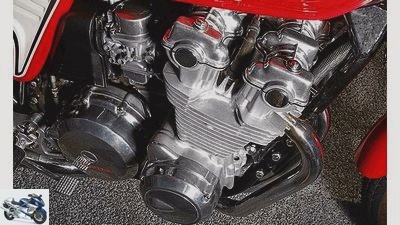
Artist
With carburettor engines or injectors without a lambda probe, in extreme cases with E10 the mixture can become too lean. In order to avoid heat damage, you would have to use the jets or software.
Another ten percent came from sugar cane from plantations outside of tropical rainforests. This is guaranteed by the biofuel sustainability regulation. In addition, only carbohydrates are used for alcoholic fermentation, the proteins are retained as animal feed.
Nevertheless, the German environmental associations reject E10. They see a “tank or plate problem”, the shortage of global food, especially for the poorest countries. In addition, there would be a high use of chemicals and energy in conventional agriculture – bio-fuel does not mean bio-cultivation. Agro-fuel could also endanger tropical rainforests indirectly: if arable or pasture land were converted into cultivation areas for ethanol plants and forests were cleared to replace them. This would be an ecological catastrophe and would turn the CO2 balance negative
Second generation biofuels are not based on food, but on plant residues. Pilot plants that produce gasoline from straw and wood waste are in Karlsruhe and Freiberg / Saxony. The conversion (pyrolysis) of the cellulose, however, requires temperatures of over 500 ° C and therefore a lot of energy. Scientists are feverishly looking for new, better bio-fuels, for example from algae or bacterial strains from beef stomachs. The finiteness of fossil oil reserves, regardless of whether they will last 30, 50 or 70 years, could bring gasoline back to where it came from in the 19th century: in pharmacies.
Winter tips
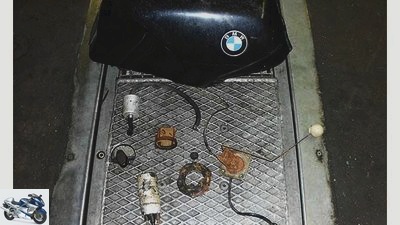
Hank
The tank and the innards of this BMW K 100 were half filled with E5 and ready for scrap after two years.
Depending on the season, summer or winter petrol is available in stores. And what do you have to pay attention to when overwintering?
In order to enable an ignitable, gaseous fuel-air mixture in the combustion chamber, gasoline has to evaporate: You step on the gas. But this volatility has to be suitable for a wide variety of temperatures. Therefore, all types of gasoline are delivered in summer and winter quality. In winter fuel, increased proportions of volatile components such as butane (C4H10) ensure better ignitability during a cold start. They are less contained in summer gasoline with its lower vapor pressure in order to prevent vapor lock formation in the fuel system.
Winter fuel is available in Germany from November 15 to March 15, and summer fuel from May 1 to September 30. In the periods in between, the filling stations serve “transitional goods”, mixtures of summer and winter fuel. If a motorcycle is refueled with winter fuel at the end of the year and then put out of service, the high butane content on warm spring days can cause stuttering while idling or even killing the hot engine. With carburetor engines, volatile substances tend to “evaporate” from the float chambers and thus provoke unwillingness to start.
In order to have enough reserves in terms of knock resistance even after long periods of idle time, we recommend higher-octane fuel, Super Plus or “Premium” (Aral Ultimate 102, Shell V-Power Racing). Important: Before mothballing, the motorcycle’s tank must be as full to the brim as possible. This minimizes the volume of air above the fuel and the so-called “tank breathing”. When the temperature rises, warm air is forced out through the tank ventilation and when the temperature falls, more humid air is sucked in again. If the tank is full to the neck, only a small amount of water can get into the fuel.
If the tanks are barely full, however, separate water phases can form, which, because they are heavier than petrol, settle on the bottom of the tank. There they can cause considerable corrosion, including rusting through tank folds and other “innards”. Ethanol dissolves in both water and gasoline, mediating between the two. And it has a hygroscopic, water-attracting effect. According to Aral chemists, E10 is more suitable for wintering than Super E5. Its twice as large proportion of ethanol can hold twice as much water in a homogeneous solution and thus render it “harmless”.
At 20 ° C, E10 binds about one percent of water until it separates, at 0 ° C only 0.5 percent. If there is more water in the tank, it is separated from the gasoline together with the ethanol (phase separation) and forms a highly corrosive mixed water-alcohol phase on the bottom of the tank. In the above, now ethanol-free, petrol, the knock resistance decreases, which harbors the risk of serious engine damage. E10 can significantly reduce these effects when the tank is full to the brim.
E10 compatibility
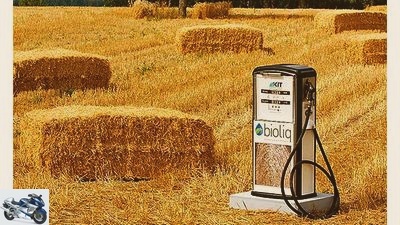
Karlsruher Institute for Technology
Is that the future? The bioliq process converts residual biomass into gasoline.
Aprilia
All scooters from 2000 tolerate E10 (two-stroke only with the prescribed oil). The endurance test is still pending for motorcycles. The recommendation is: continue to fill up with E5.
BMW
Use in all BMW motorcycle models of all years of construction (!) Is harmless.
Buell
Buell engines can tolerate the higher proportion of ethanol in the fuel, but due to the higher octane number, Super Plus (RON 98), i.e. E5, is recommended for them.
Ducati
Machines from model year 1999 onwards have been tested so far. Of these, E10s: Monster 696, 796, 1100 / S / Evo; Hypermotard 796, 1100 / S / Evo / EVo SP; Multistrada 1200 / Sport / Touring; Diavel / carbon; 1198 SP and 1098 R Corse; Desmosedici RR.
Harley-Davidson
All standard Harley-Davidson engines from model year 1980 can handle E10.
Honda
Most models that meet at least the EURO 2 emissions standard, as well as motorcycles built after 1990, can be refueled with E10. With a few exceptions, older vehicles can also handle E10. The exceptions are in the driver’s manual, chapter fuel.
Kawasaki
At the moment there is a release only for models from 2006 onwards.
KTM
E10 fuel is safe for all current models; but the 1190 RC8 R and RC8 Track require 98-octane Super Plus or even premium gasoline with 100 octane (RON) – this is only available as an E5.
Moto Guzzi
The endurance test is still pending. The recommendation is: continue to fill up with E5.
Suzuki
E10 is safe for all models from 2002 and some between 1992 and 2002; but not for Suzukis before 1992.
triumph
All models from the Hinckley era, i.e. from 1990 onwards.
Yamaha
All Yamaha motorcycles and scooters built after 1990 are approved for the Super E10. Yamaha recommends “emptying the fuel system” when refueling with E10 after a period of four weeks, which means: empty the carburetor, fill the tank to the brim. In fact, the chemical aging stability of ethanol is high.
Related articles
-
manufacturer counselor workshop Gasoline chores Fuel, gasoline, petrol, … Where from, where to – and why? (Almost) nothing works on a motorcycle…
-
Everything about gasoline: grades, anti-knock properties and additives
jkuenstle.de counselor workshop Everything about gasoline: grades, anti-knock properties and additives Report: All About Gasoline Part 2 Types of petrol,…
-
Shell Blue Gasoline: Less CO2 through new gasoline
Jahn 2 pictures Jahn 1/2 E10 fuel has been available in Germany for 10 years, but it has not really caught on. The E5 fuel that it was supposed to…
-
Comparison test gasoline consumption
Bilski 41 pictures Bilski 1/41 If you only take your motorcycle out of the garage on Sundays, you don’t care about the fuel consumption of your…
-
Practical test: gasoline consumption
counselor workshop Practical test: gasoline consumption Practical test: gasoline consumption Consumption advice Work makes you thirsty. That applies to…
-
Pros and cons of the Honda VFR 800 and VFR 750
jkuenstle.de 35 pictures Honda 1/35 Careful facelift: the V4 classic VFR is entering the 2006 season. Honda 2/35 Careful facelift: the V4 classic VFR is…
-
Sports & scene The pros: airbrush The pros: Airbrush (archive version) Brush hour If unusual motifs are desired on helmets or motorcycle parts, then the…
-
Gasoline consumption of motorcycles
Tyson Jopson 13th pictures Tyson Jopson 1/13 What is the current state of affairs in terms of fuel consumption? A series of experiments. Tyson Jopson…
-
Mona Pekarek 10 pictures 1/10 2/10 3/10 4/10 5/10 6/10 7/10 8/10 9/10 10/10 counselor workshop Guide to downtime and petrol Guide to downtime and petrol…
-
Husqvarna 701 Vitpilen-Svartpilen recall: Possible gasoline leak
Husqvarna counselor traffic & business Husqvarna 701 Vitpilen / Svartpilen recall: Possible gasoline leak Husqvarna 701 Vitpilen / Svartpilen recall…